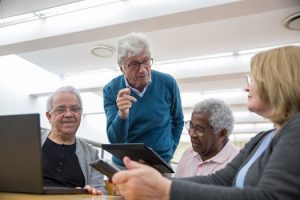Transnational Learning Communities
If there’s one thing that has been made abundantly clear in recent times, it’s that the world is becoming more interconnected than ever before. With the rise of technology and the ease of global communication, it’s becoming increasingly common for people from different nations and cultures to come together to share knowledge and learn from one another. This has given rise to a new educational concept known as Transnational Learning Communities.
The Basics of Transnational Learning Communities
Transnational Learning Communities (TLCs) are collaborative learning spaces that bring together individuals from multiple countries and cultures to engage in a shared learning experience. These communities are typically formed around a common theme or goal, such as a specific academic subject, social issue, or professional development opportunity.
Unlike traditional classrooms, where the focus is often on a single teacher or set curriculum, TLCs are designed to promote peer-to-peer learning and collaboration. Participants in TLCs come from diverse backgrounds and bring unique perspectives, making for a rich and dynamic learning environment.
The Benefits of Transnational Learning Communities
1. Diverse Perspectives
One of the biggest advantages of TLCs is the opportunity to learn from a variety of perspectives. With participants coming from different cultures, languages, and educational backgrounds, there is bound to be a wealth of knowledge and experiences to draw from. This not only enhances the learning experience but also promotes cultural awareness and understanding.
2. Improved Language Skills
In a TLC, participants are often required to communicate in a shared language, such as English, regardless of their native tongue. This presents a unique opportunity for language practice and improvement, as individuals are motivated to express themselves and engage in discussions with their peers.
3. Networking Opportunities
TLCs provide an excellent platform for networking and connecting with individuals from different countries and industries. This can open up a world of opportunities for personal and professional development, as well as potential collaborations and partnerships.
4. Global Perspective
As TLCs bring together individuals from different parts of the world, they offer a unique opportunity to gain a global perspective. This is especially beneficial in today’s interconnected world, where international knowledge and cultural competence are highly valued.
Challenges of Transnational Learning Communities
While TLCs offer numerous benefits, they also come with their own set of challenges. These may include language barriers, differences in time zones, and varying levels of technological access. However, these obstacles can often be overcome with proper planning and resources.
Examples of Transnational Learning Communities
1. International Study Programs
Many universities offer study abroad programs where students can spend a semester or year studying and living in a foreign country. These programs not only allow for academic learning but also provide a unique opportunity for participants to immerse themselves in a different culture and form lasting connections with their peers.
2. Online Language Exchange Programs
With the rise of online communication platforms, language exchange programs have become increasingly popular. These programs pair individuals who are looking to improve their language skills with native speakers of their desired language. This provides a convenient and cost-effective way to practice speaking and improve language proficiency.
3. International Conferences and Workshops
Conferences and workshops that bring together professionals and academics from different countries and backgrounds can also be considered as Transnational Learning Communities. These events offer a space for sharing knowledge, networking, and collaborating on mutual interests and goals.
Conclusion
Transnational Learning Communities offer a unique and valuable learning experience in today’s globalized world. By bringing together people from different cultures and backgrounds, TLCs promote diversity, cultural understanding, and the exchange of knowledge. With technology continuing to break down barriers, the opportunities for TLCs are endless, making them a vital part of modern education.







